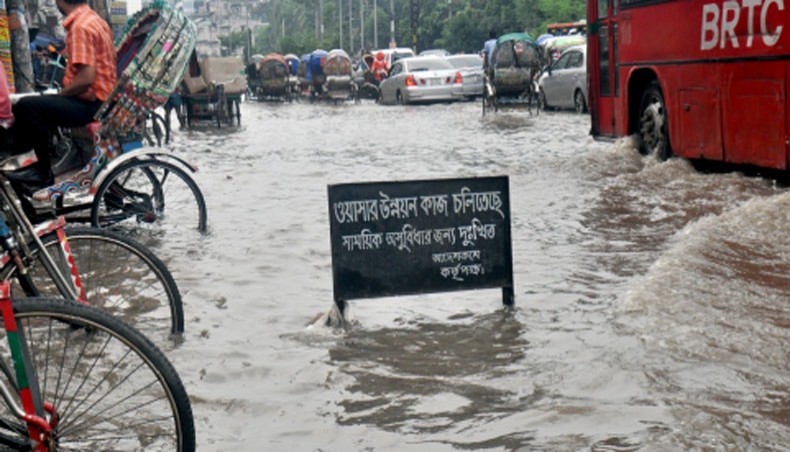Is Dhaka turning into a Durvasa city?
UNLESS we do at least some things right, Dhaka is, we have ample reasons to fear, turning into a Durvasa city. In Hindu puranas, Durvasa, son of Atri and Anusuya, is a rishi (sage) who, it is said, is impossible to live with. The very name Durvasa means ‘one who is impossible to live with. Dhaka, like Durvasa, is turning into a city impossible to live in.
As dwellers of Dhaka, we are witnessing degeneration of the city into a place where ‘comfortable living’ is next to impossible. Millions of people suffer the same fate of exhausting traffic situation, water-logging, loss of work and recreation hour and lack of public spaces, among others, in Dhaka.
A recent study published by the World Bank on July 19 showed the gruesome state of one aspect of the mushrooming capital of the country. The study showed that the average traffic speed in Dhaka has reduced from 21km per hour to 7km per hour in the last 10 years.
The average speed, if we are to believe it (as we dwellers have reasons to reckon the average speed to be less than 7km per hour), is slightly more than normal walking speed.
The World Bank study also points out that the dire traffic situation eats up 3.2 million work-hours every day. One can add, if one wish like me, hours for other things than what we mean by work-hour.
The study also has some alarming revelations for us. For example, it gives a rough statistics of population in the next 20 or so years. If the current rate of growth of residents continues in Dhaka, its population will surpass 35 million by 2035 and, the study calculates, the traffic speed will come down to 4km, which is less than walking speed.
Needless to say, the reduction of average traffic speed is caused by uncontrolled growth of traffics.
The traffic has increased, various studies show, by around 150 per cent in the last ten years. In the same period of time, population has increased around 50 per cent, while roads have increased less than 10 per cent.
All these rough and ready statistics is reflected in everyone’s face who brave the city roads. The traffic situation alone of the once opulent Zannatabad is enough to turn its residents’ lives really uncomfortable.
While thinking about these upsetting revelations by the World Bank study, I, like all Dhaka dwellers, saw what heavy, or even a moderate, rain can do to the city. In the last three weeks, Dhaka experienced heavy or moderate rainfalls on several days. The result of these rains on the city was nothing short of havoc.
In the past week I experienced how unbelievably one kilometre could swallow 3 hours which means the traffic speed reduced to 0.33 km per hour.
It is not that Dhaka was like this always. Any elderly Dhaka dweller will tell you how happily they lived in the city with enough public space, with good and healthy environment, with four rivers circling the city even three decades ago.
Even in the 1980s Dhaka did not suffer such havoc after heavy rains as the city had enough surrounding wet and low-lying lands, flood-flow zones and natural canals for gradual, but rapid, drainage.
Now, most of the wetlands and natural canals are encroached on making water-logging a common painful condition for the residents.
Newspaper reports and some studies tell us that ‘developers’ have filled up nearly 70 per cent of the wet and low-lying lands, flood-flow zones and natural canals of the capital for progressive, one may read aggressive, urbanisation.
There are many studies, done by the government and non-government research bodies, which show us different figures of percentages of the reduction of wet and low-lying lands in Dhaka. The reduction figures, as I looked up, range between 52 to 85 per cent in the last five decades.
Since the wet and low-lying lands are the only surface water drainage system, the reduction of these lands is making Dhaka nakedly vulnerable to water-logging and flooding.
What is worrisome for us is that the proposed 21 per cent of city’s present and projected areas, which Rajdhani Unnayan Kartripakkha proposed to reserve as water bodies in the the Detail Area Plan adopted in 2010 under the master plan prepared in 1995, is not being maintained.
Rajdhani Unnayan Kartripakkha, the government agency responsible for planning the capital city and enforcing relevant laws to control its urbanisation, has been reported to have flouted its own proposed plans and has allowed projects on areas that it labelled as flood flow zones in the DAP. If the authorities concerned do not pay immediate attention to, and ensure proper natural drainage system of rainwater through canals and also ensure preservation of wet and low-lying lands, Dhaka, with all its glitters and glows, will turn into chaos of a megacity.
Since Dhaka cannot afford comfortable and standard city life to even one third of the total population (it is around 18 million now) and its roads cannot afford one third of the traffics that the city is forced to accommodate, well-planned measures are a must to make the city liveable. Otherwise, Dhaka is going to be a Durvasa city for its ballooning population.
News Courtesy: www.newagebd.net











